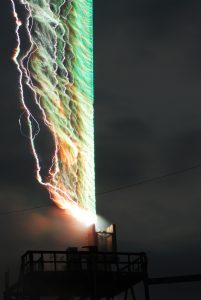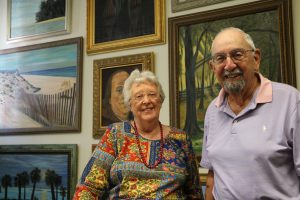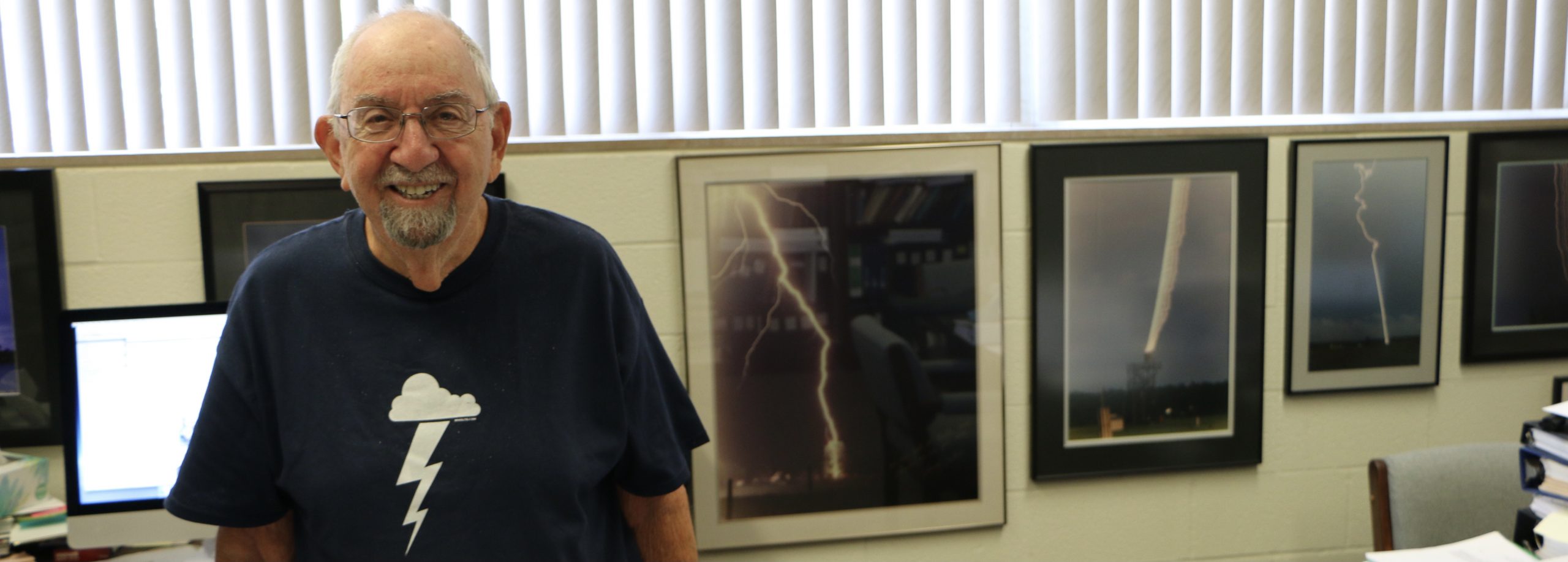2021 was an important year for Dr. Martin A. Uman—it marked his 50th year at the University of Florida, the year he retired, and the year his title formally became Emeritus Distinguished Professor.
As his Curriculum Vitae will attest, Dr. Uman looms large in the field of lightning research. He is considered by many to be one of the world’s leading experts on lightning physics and lightning protection. With seven patents, a UF career total of $28M in contracts & grants, seven books, and 267 published articles in reviewed journals, his influence in the field is hard to overstate. Surprisingly, his path into the lightning field was far from straightforward—it was, as he says, a series of interesting accidents.
We sat down with this titan in the field of lightning research to ruminate, reminisce, and to just talk about his career.
What led you into the lightning field? Was it something you were always interested in?
I grew up in Tampa, FL, so I saw a lot of lightning and I was always interested in it, but I didn’t scientifically study lightning until I had my PhD and I had my first job, which was as a faculty member at the University of Arizona in Tucson. I had done my PhD on some aspects of plasma physics, and you can find those first few journal papers on electron drift velocity and energy in gas mixtures in my CV.
Well, when you look at the list of papers and publications, you can see see something shifted in 1965.
Yeah, it switches. It’s an interesting series of accidents. I was at Arizona, doing what I had been doing for my PhD, calculation and measurement of electron behavior in gases. I met a guy who was looking at lightning spectra, the colors that get spread out when you see a lightning strike. An astronomer, basically. And I was able to help him with some theory and help some of his graduate students with some theory about how you analyze the spectra and he and I and his graduate students were able to measure lightning temperature, electron density, and a few other things.
You can use that type of spectra even on other planets to see what kinds of gases are present, right?
Absolutely. So I helped them with the spectroscopy and some other things, but I was still doing my main project with my graduate students. I stayed at Arizona for four years, and then I left. The faculty there was really conservative, and old, and they believed that EE was electrical machinery, and I wanted my PhD students to be able to take physics courses, and they wanted them to take power and machinery courses. So, after four years, I went to Westinghouse Research Labs in Pittsburgh, which had offered me a job after I got my PhD. And that was the leading place in the country, maybe the world, doing atomic physics. They had some really high-class scientists there.
What was it like to transition from academia to industry? What would you say is the main cultural difference between the two worlds?
Well, the Westinghouse Research Labs was wonderful. The main difference is that they provided anything that you could want. You want an electric circuit built, they have a department that does that for you. If you needed something written, they had a secretary that would do that for you right away. Whereas at a university, you do everything yourself or else your grad students do. It’s really inefficient. But you get to do whatever YOU want to do. When I went to Westinghouse in 1964, I thought that I was just going to continue doing what I had been doing on my PhD thesis. But about the same time, the world got interested in a 707 aircraft that had been destroyed by lightning [Pan Am Flight 214, Dec. 1963]. It blew up and everyone on board was killed. And so, there was a great deal of interest in how exactly something like this could happen.
What year was this?
The plane blew up in ’63, I think. Another important event was Apollo 12 [November 14, 1969], which was struck by lightning just after it launched for the Moon. The bottom line is that after 1963, there was a huge amount of government money all of a sudden to study lightning.
In terms of how do we prevent it from destroying equipment?
Well, in terms of what’s going on. With Apollo 12, nobody understood that it was triggered lightning. So that was the first triggered lightning by accident by a rocket, though there were others after that. So, between the 707 and Apollo 12, there was a huge amount of money available, and I turned out to be the only one in the Research Labs at the time that had any lightning background, because I’d done this spectroscopy and some related work. But I went to Westinghouse—not to do lightning, but to do atomic physics. But on the other hand, they had their interests, so I was encouraged/told to apply for all this contract money. As a result, I did nothing but study lightning for seven years at Westinghouse. And while I was there I wrote a lot of papers and two books on lightning, and got involved with Kennedy Space Center (KSC), very seriously… I was going every summer to KSC, flying back and forth between Pittsburgh to KSC during the year a lot of times, working mostly on the problem why Apollo 12 and later AtlasCentaur 67 made a lightning or why lightning struck when the weather folks thought they were launching in safe conditions.
And why did that happen?
Because if you put any piece of metal that’s long enough in an electric field, the metal enhances the electric field at each end to electrical breakdown. And if you make the electric field big enough in the presence of a thunderstorm, if you enhance it enough, the electric breakdown turns itself into a real lightning. So you can trigger or cause lightning. Airplanes trigger lightning all the time. The typical commercial airliner is “struck” by lightning once a year and 95% of those are triggered by the plane itself.
Who, or what entity, had the idea to trigger lightning using rockets and wire to trigger lightning?
It’s generally attributed to a guy named Morris Newman, who shot small rockets trailing wires off of a ship that he operated with an Air Force contract. He didn’t make any scientific measurements, not significant ones anyway, it was a demonstration for the military. And then after that, a group in France took it up, more or less developed the proper way to unspool wire, determined the kind of rockets that were the best to use, and started doing it. The major triggering program when I was at Westinghouse was at Kennedy Space Center. Obviously, they were extremely interested in what was going on. So KSC, the northern part of the Cape, was set aside for NASA’s triggered lightning facilities.
Was the goal building systems to protect equipment?
Well, in the long term, yes, but in the short term, the thought was just to find out under which conditions you don’t launch your rocket. For instance, the value of electric field. If it’s above a certain value, the length of the rocket is going to enhance it to the level where it’s going to make its own lightning.
So, you joined UF in 1971?
Yes
Which world do you prefer—industry or pure academia?
Well, my ideal time was here in academia, when I was operating the triggering facility at Camp Blanding, a military base near Starke, and had enough money to do so properly, thanks to DARPA (The Defense Advanced Research Projects Agency). I had about five PhD students at any one time—which is about as many as anyone should ever handle, in my opinion—that was a really exciting period. We used triggered lightning to study the physics and nature of lightning.
When did the UF triggered lightning facility at Camp Blanding start up?

The UF triggered lightning facility at Camp Blanding (which we called the International Center for Lightning Research and Testing—ICLRT) started in ’94. We had built a number of mobile facilities before—we started with a little white truck in 1973 that we drove all over the state, and parked at the Ocala airport for a couple of summers. Then we outfitted a full semi trailer for lightning measurements, the tail end of it had ‘University of Florida Lightning Lab’ painted on it. We used that until the early ’90s.
But in 1992, the KSC triggered lightning facility got shut down because of a rocket accident. So, the funding agencies who were paying for that part of the work, and NASA, wanted to go some place else and continue the work. Electric Power Research Institute, which funded some of the things that were going on at KSC, found Camp Blanding in 1993. They funded a company called Power Technologies, Inc. to set up a facility like the one we had at KSC. And we went out there and were working just like we did at KSC, except we couldn’t just go home at night and jump in the Atlantic Ocean. (laughs) We took the facility over in 1994 and it will operate until the spring of 2022, when it will be returned to the military. The lease is up then. At present, we’re winding down, cleaning it up…
We were a self-contained operation at Blanding. We had power lines set up, bucket trucks, it was a major operation. In the DARPA years, roughly 2005–2016, the whole world came here, it was wonderful.
What was DARPA’s goal with all of this research?
It was never specifically said this way, but the more you know about the physics of something, the better you can design and deploy protection and the better you can understand the damage it can do. So I think that’s what’s in the background. I got a call out of the blue. The guy from DARPA said they’d like to do a lightning program, and could I write up a proposal laying out what I thought the major problem areas are that we could work towards solving. Those are: lightning initiation, how does it get started in the cloud, how does it propagate, and how does it attach to the ground. And then we enlisted groups all around the country who wanted to get involved with it… and after the first couple of years it was going good, we were finding out things, publishing a lot. The folks who were in charge of it I think were just interested in the science. There might have been a general somewhere who was interested in making a weapon out of it, but… it’s not unreasonable to think that someday, we might be able to stop or start it.
What about painting? When did you start exercising that part of your brain?
Well, the history of that is that I always drew. I still have pictures of my bedroom from when I was a kid in Tampa.
Are they good?

Not bad, not bad. I never really did any painting, but when I was in college, I took a number of art history classes. In college in the 1950s, I was always interested in that. On weekends sometimes I’d go to New York City and wander around the MoMA, the Met, and I had a lot of interest in art in general. And in 1989, while I was at UF, I saw an advertisement for a night class at Santa Fe Community College, oil painting. And I thought, ‘what the hell!’ (laughs) The course was taught at the junior high school on 34th St. and the instructor explained about all the equipment you’d need, the kinds of brushes, the type of oil, all those things. Very helpful. And then we started painting, and in my opinion, I could do it pretty well.
And so, with no training at all, that was your first experience of painting?
Well, I had also read a lot of books on painting techniques, but the fact that I could do it at all surprised me. It’s actually quite technical—a lot about color, perspective, layering paints, which ones you can see through, which ones you can’t, brush strokes, paint dry time, and so on. So there’s a lot of thinking that you gotta do when you plan and work on a painting. On the other hand, I’d looked at enough paintings in museums, bought some paintings, to know what I can and can’t do. So from then on, I just started doing it as a hobby, it’s just a mental relaxation.
When you’re painting, do you find yourself working out some research problem in the back of your head?
No. When I’m painting, I’m in the painting. It’s an all-consuming thing, with a lot of different aspects that I am forced to focus on.
Talk about the work looking for lightning in Jupiter’s atmosphere
I have a certificate here that flew in the space shuttle, thanking the group I was in. I was on the NASA grant, to build and test an instrument that eventually went to Jupiter, the Galileo mission. The spacecraft measured lightning magnetic fields in the Jovian atmosphere. The whole idea at that time was to see if Jupiter had any lightning and if so, to measure its properties. Last week, on TV, there was video of a flyby of the latest spacecraft sent by Jupiter. You could see the lightning in the clouds, it illuminated the clouds. Back then, in the time of the Galileo mission, nobody knew if there was lightning on Jupiter.
If there is, can you make certain assumptions about atmospheric conditions?
Right, but then you have to understand the kinds of thunderstorms they had, whether it’s ice-water clouds, how deep the clouds are, how much energy is involved. The idea of lightning on other planets was certainly exciting. And it still is!
Have we seen evidence of lightning on other planets in the solar system?
I guess the answer is, it depends who you ask. There is certainly electromagnetic noise that could be from lightning on several planets—Saturn, Uranus—and there’s some thought that there may have been some on Venus at one time when the Russians had a spacecraft there. But actual lightning light—no one has seen actual illuminations on Venus. Jupiter and Saturn are the places where it’s most certain that there is lightning. There’s just a lot of convection, a lot of clouds. So, yeah, the group that I was involved in, Galileo, looked at lots of things, not just lightning, lightning was a small part of it. But it was a really fun part.
What was it like to know that your work was flying through space?
It was very exciting. The certificate was on the wall there, and also a painting I did of the Moon and the Earth from a photo taken by Galileo on its way to Jupiter.
I want to finish up by asking can you tell us, for once and for all, should we be afraid to take a shower during a thunderstorm?
I probably wouldn’t take a shower during a thunderstorm. People have been killed, not many, but a lot have been shocked for instance, washing dishes. If you have metal pipes in your house—though now pipes are mostly PVC, but some hot water pipes and drain pipes are still metal—and lightning strikes out there some place nearby, you can get voltage on the metal pipes and the water, and that can happen in the shower. I don’t know of anybody that’s been killed in the shower, but it’s hard to know about that because it doesn’t get published.
What about talking on a cell phone during a storm?
No, no problem on a cell phone. So, either you lightning protect your house, make sure that all the wires on the roof are bonded and well-grounded, or I would just stay away from electricity and the water pipe system during a thunderstorm. The odds of a house getting hit in Florida is something like once in 30 years, so your odds are pretty good. But on the other hand, you figure 1 in 30 houses is going to get hit every year—that doesn’t sound as good.

